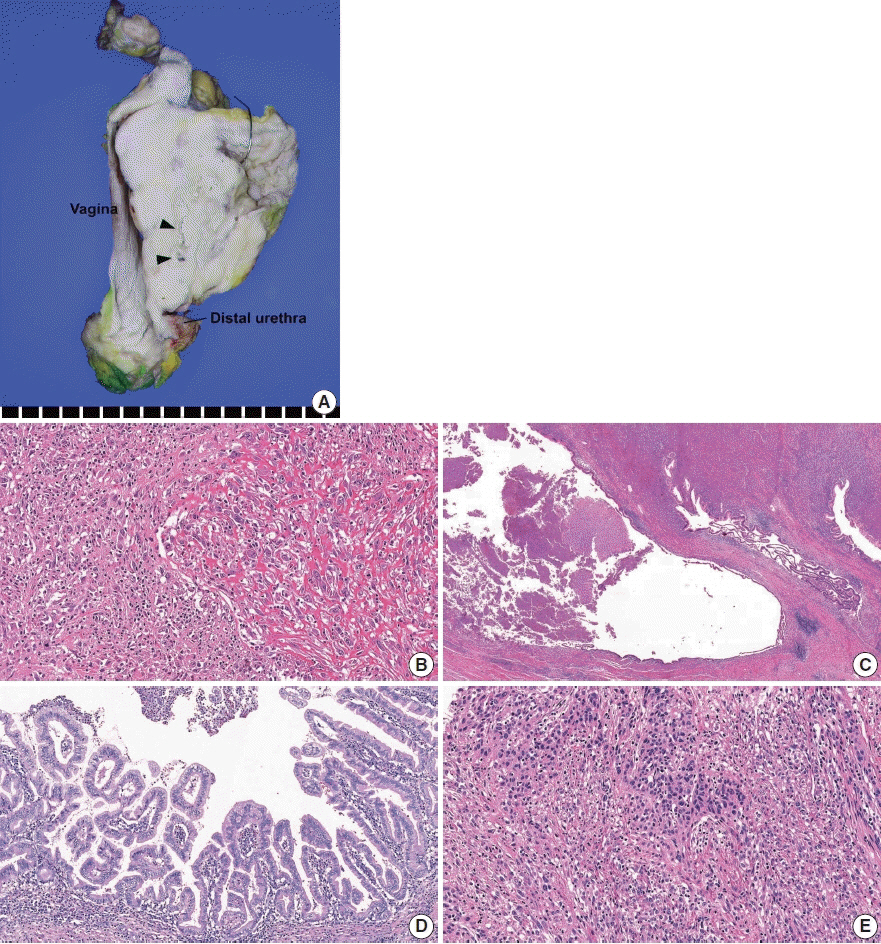J Pathol Transl Med.
2021 Jul;55(4):298-302. 10.4132/jptm.2021.04.23.
Sarcomatoid urothelial carcinoma arising in the female urethral diverticulum
- Affiliations
-
- 1Department of Pathology, Ewha Womans University Seoul Hospital, Seoul, Korea
- KMID: 2518430
- DOI: http://doi.org/10.4132/jptm.2021.04.23
Abstract
- A sarcomatoid variant of urothelial carcinoma in the female urethral diverticulum has not been reported previously. A 66-year-old woman suffering from dysuria presented with a huge urethral mass invading the urinary bladder and vagina. Histopathological examination of the resected specimen revealed predominantly undifferentiated pleomorphic sarcoma with sclerosis. Only a small portion of conventional urothelial carcinoma was identified around the urethral diverticulum, which contained glandular epithelium and villous adenoma. The patient showed rapid systemic recurrence and resistance to immune checkpoint inhibitor therapy despite high expression of programmed cell death ligand-1. We report the first case of urethral diverticular carcinoma with sarcomatoid features.
Figure
Reference
-
References
1. Ahmed K, Dasgupta R, Vats A, et al. Urethral diverticular carcinoma: an overview of current trends in diagnosis and management. Int Urol Nephrol. 2010; 42:331–41.
Article2. O’Connor E, Iatropoulou D, Hashimoto S, Takahashi S, Ho DH, Greenwell T. Urethral diverticulum carcinoma in females: a case series and review of the English and Japanese literature. Transl Androl Urol. 2018; 7:703–29.3. Derksen JW, Visser O, de la Riviere GB, Meuleman EJ, Heldeweg EA, Lagerveld BW. Primary urethral carcinoma in females: an epidemiologic study on demographical factors, histological types, tumour stage and survival. World J Urol. 2013; 31:147–53.
Article4. Rajan N, Tucci P, Mallouh C, Choudhury M. Carcinoma in female urethral diverticulum: case reports and review of management. J Urol. 1993; 150:1911–4.
Article5. Gu L, Ai Q, Cheng Q, et al. Sarcomatoid variant urothelial carcinoma of the bladder: a systematic review and meta-analysis of the clinicopathological features and survival outcomes. Cancer Cell Int. 2020; 20:550.
Article6. Lembo F, Subba E, Lagana AS, Vitale SG, Valenti G, Magno C. Intradiverticular sarcomatoid carcinoma of the bladder: an overview starting from a peculiar case. Urol J. 2016; 13:2800–2.7. Wang Y, Liu H, Wang P. Primary sarcomatoid urothelial carcinoma of the ureter: a case report and review of the literature. World J Surg Oncol. 2018; 16:77.
Article8. Rashid S, Akhtar M. Sarcomatoid variant of urothelial carcinoma of the renal pelvis with inferior vena cava tumour thrombus: a case report and literature review. Case Rep Pathol. 2018; 2018:1837510.
Article9. D’Arrigo L, Costa A, Fraggetta F, Pennisi M, Pepe P, Aragona F. Carcinosarcoma of the female urethra. Urol Int. 2016; 96:370–2.
Article10. Moch H, Humphrey PA, Ulbright TM, Reuter VE. WHO classification of tumours of the urinary system and male genital organs. 4th ed. Lyon: International Agency for Research on Cancer;2016. p. 92.11. Bostwick DG, Cheng L. Urologic surgical pathology. 3rd ed. Philadelphia: Saunders-Elsevier;2014. p. 298–9.12. Sanfrancesco J, McKenney JK, Leivo MZ, Gupta S, Elson P, Hansel DE. Sarcomatoid urothelial carcinoma of the bladder: analysis of 28 cases with emphasis on clinicopathologic features and markers of epithelial-to-mesenchymal transition. Arch Pathol Lab Med. 2016; 140:543–51.
Article13. Balar AV, Galsky MD, Rosenberg JE, et al. Atezolizumab as first-line treatment in cisplatin-ineligible patients with locally advanced and metastatic urothelial carcinoma: a single-arm, multicentre, phase 2 trial. Lancet. 2017; 389:67–76.
Article14. Powles T, Duran I, van der Heijden MS, et al. Atezolizumab versus chemotherapy in patients with platinum-treated locally advanced or metastatic urothelial carcinoma (IMvigor211): a multicentre, openlabel, phase 3 randomised controlled trial. Lancet. 2018; 391:748–57.
Article15. Li H, Zhang Q, Shuman L, et al. Evaluation of PD-L1 and other immune markers in bladder urothelial carcinoma stratified by histologic variants and molecular subtypes. Sci Rep. 2020; 10:1439.
Article
- Full Text Links
- Actions
-
Cited
- CITED
-
- Close
- Share
- Similar articles
-
- A Localized Sarcomatoid Carcinoma of a Urinary Bladder Diverticulum
- A Case of Female Urethral Diverticulum Combined with Multiple Stones
- Sarcomatoid Urothelial Carcinoma of the Renal Pelvis with Extremely Aggressive Clinical Behavior
- Three Cases of Urethral Diverticulum in the Female
- A case of urethral diverticulum combined with stone




